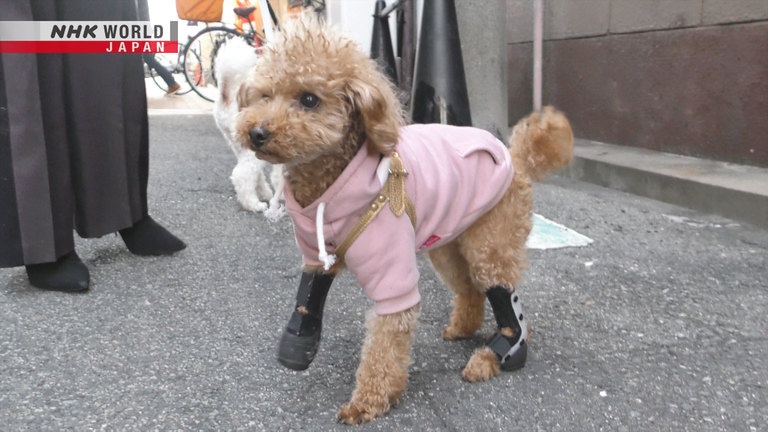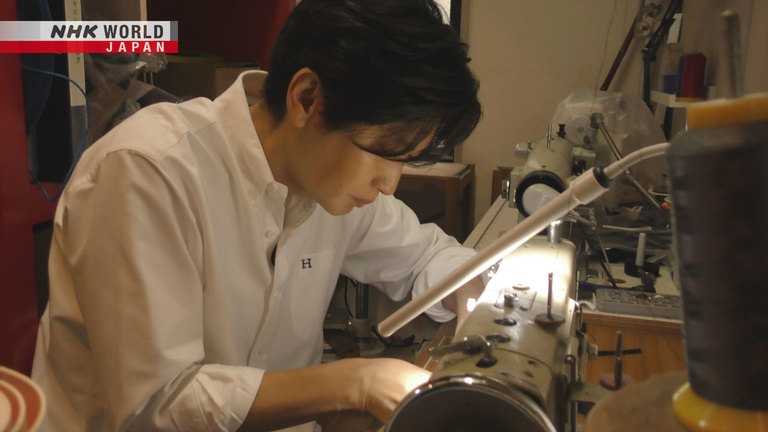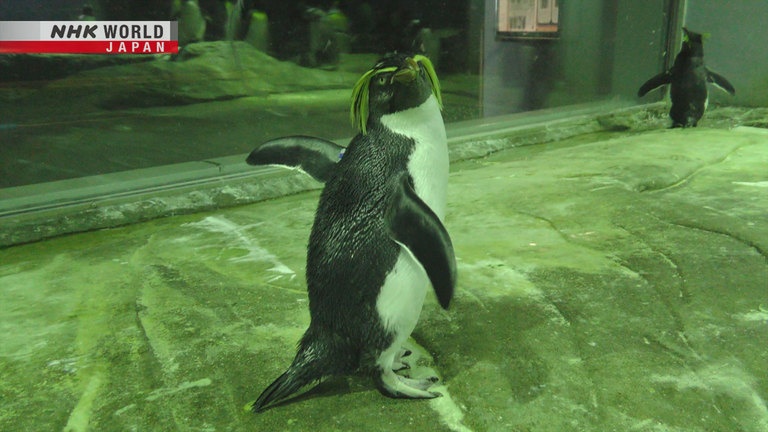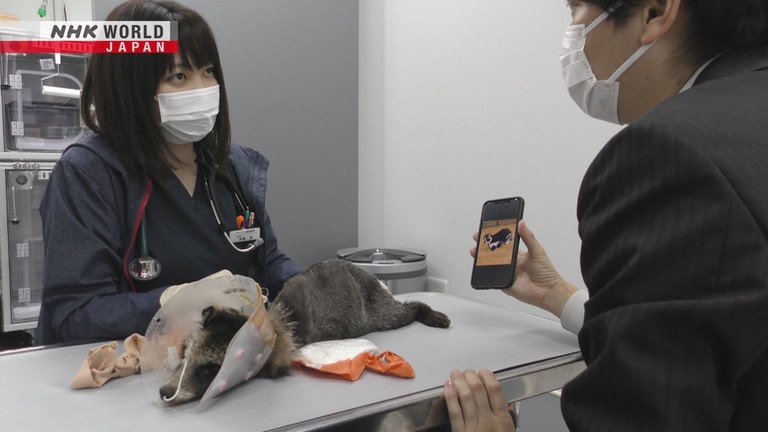A New Lease of Life for Infirm Animals: Veterinary Prosthetics Pioneer - Shimada Akio
Around the world, cats, dogs and other pets are an integral part of many families. But while improvements to diet and veterinary care have brought increased lifespans, they have also seen an increase in health conditions that affect elderly pets. Shimada Akio is Japan's first veterinary prosthetist, pioneering custom prosthetics and rehabilitation schemes that preserve quality of life for animals who would once have been beyond help, including pets, wild animals and zoo residents.




Transcript
"RISING"
Shachi the chihuahua is ten years old.
Equivalent to her mid-50s in small dog years,
she is approaching senior status.
Due to the impact of heart disease and poor circulation,
she has recently had surgery
to amputate her right hind leg at the ankle,
compromising her mobility.
Her owner is concerned.
Our house has slate-tiled floors,
and the stump clacks against them.
It looks painful.
She wonders how the disability will affect Shachi in old age.
As she gets older, it might be hard to poop with just three legs.
Her regular veterinarian sees no simple surgical solution.
So, they turn instead to Japan's leading veterinary prosthetist,
Shimada Akio.
I'm thinking the prosthetic should fit up to the top of her leg.
First, we'll take a plaster cast.
To get an exact fit, Shimada makes a plaster mold of Shachi's stump.
And this will be used to form the basis of a prosthetic limb
that will restore to her the gift of mobility.
Elderly dogs suffer from a wide range of physical difficulties.
Take Yorkshire terrier, Lien.
Now 12 years old, she was raised from a puppy by owner Maruo Yukiko.
She was such a good walker, but now it seems tough for her.
Lien's left hind leg has become prone to painful dislocations,
hampering her mobility.
She's 12 years old now, but she loves her walks.
I hope there's a way to keep her walking as long as possible
without resorting to surgery.
It looks sore.
Her leg's twisted inwards, and she can't extend it herself,
so we'll fit a brace to do that for her.
Shimada fields numerous requests like these
from the owners of elderly and disabled pets
struggling with their mobility.
If I'm going to make something, I want to do it properly.
Restoring happiness to pets and their owners is very fulfilling for me,
so that's what I want to keep on doing.
This time on "RISING,"
we follow a prosthetics pioneer
creating a new lease of life for infirm animals.
"A New Lease of Life for Infirm Animals" Veterinary Prosthetics Pioneer - Shimada Akio
The west-Tokyo suburb of Machida is home to
Shimada Akio's prosthetics workshop.
Here, with the assistance of four staff,
Shimada creates his veterinary prosthetics and orthotics.
Today, he's working on a leg for Shachi,
the chihuahua who lost her foot due to cardiovascular issues.
The plaster mold he made was used to cast this model of Shachi's leg.
Every item is made to measure for individual animals.
The prosthetic limbs are covered in the same material
that wetsuits are made from.
And the smaller the patient, the more precise the work.
A ten-kilo dog is five times bigger than a two-kilo dog.
So of course, you have to adjust the size and the materials to match.
That's a given.
The socket will be lined with shockproof gel.
Sold to protect furniture and ornaments from earthquakes,
this material provides the ideal shock absorption for little legs.
The cover is stitched by Shimada's colleague, Kaneda Yumi.
This, too, calls for some non-standard approaches,
like bringing the inner seam outside the garment.
For elegant clothes, you'd have the seam inside.
But that can irritate dogs' skin, so we bring it outside.
Meanwhile, load-bearing segments are stitched by hand
rather than machine.
Hand stitching affords a little bit more give.
The stiffness of machine stitching
can sometimes be painfully constrictive.
The "foot" of the prosthetic is made from the same stiff rubber
as shoe soles, machined to the nearest millimeter.
And once all the parts are assembled,
Shachi the chihuahua's new hind leg is complete.
With something this small,
even a minor size discrepancy can hamper contact with the ground.
It's deceptively difficult, so we have to take appropriate care.
Two days later,
Shimada visits Shachi's regular clinic for a trial fitting.
Even if the fit is perfect,
it's not uncommon for dogs to reject their new limbs.
Let's go for a walk outside.
She's walking freely!
And so naturally, too.
Shachi has taken to her new leg like a duck to water.
She seemed happy to be able to walk again as usual.
She wasn't fazed at all.
Shachi can't speak but she looked pretty happy.
Meanwhile, for Lien, the dislocation-prone Yorkshire terrier,
Shimada has created a custom orthotic brace.
You can do it!
Wow, just look at her go.
Amazing!
Just like she's young again.
Maybe this can keep her mobile 'til the end!
For owner Maruo, it's a major relief to see her hopes
for Lien's lifelong mobility restored.
Higashi Sumiyoshi, Osaka.
Shimada doesn't just work with elderly animals.
Takenaka Yoko runs a local estate agency.
Aged around two and a half,
her pet poodle Kotaro was rescued from an abusive home.
He slips a lot because he can't plant his feet.
Kotaro is missing the lower portion of his right front leg,
while a snapped Achilles tendon in his left hind leg
means he is forced to get around on only two limbs.
It's OK, sweetheart.
Since Takenaka took him in six months ago,
they've yet to go for a single walk outside.
I tried to persuade him to come out with me, but he hates going out.
He's not used to it, so he gets scared,
and he won't walk on the pavement,
because it's too hard for him.
I hope that we can help him enjoy going out like a normal dog.
With Kotaro's regular veterinarian
deciding surgery would be of limited use,
they turn to Shimada for custom mobility aids.
And today, they'll be trying the completed equipment out for the first time.
70% of a dog's bodyweight is supported by the front legs,
so Shimada has prepared a prosthetic extension
to help Kotaro's right foot reach the ground.
For his left hind leg meanwhile,
Shimada has created a brace to compensate for the damaged Achilles.
Looking good.
But will Kotaro be able to walk?
Oh, is that tough, baby?
At first, he seems to be struggling.
I guess it's the extra length. He can't coordinate.
They decide on an extended trial
to see if Kotaro can get used to his new aids.
And a month later, how is he getting on?
He's taken to his new life with flying colors
and is now able to walk confidently on four legs, even outdoors.
Now he can go right up to people,
and he gets all this attention from everyone.
We're very happy.
Shimada Akio's passion for prosthetics
stems from direct family experience.
His grandfather Senkichi lost several fingers in an accident
at the factory where he worked.
He, too, used prosthetic fingers,
which showed Akio the importance of such devices.
He would go on to study prosthetic design at college,
before joining a leading manufacturer of artificial limbs for humans.
But what prompted the switch of focus to animals?
My colleague's dog had an accident in which it injured its back.
I made a support by cutting a hole in a floor cushion.
And I realized there was a niche for stuff like that.
No one else was doing it but I thought I could.
In 2007, at the age of 26,
he founded Japan's first specialist animal prosthetics business.
But at first, things were far from plain sailing.
We'd present our products,
but owners and veterinarians need concrete evidence
before they'll use something.
They weren't selling at all,
and pretty soon it seemed like we might go under.
But Shimada stuck at it,
giving his all to the few orders they did receive,
placing his emphasis on quality over cost.
Wife Noriko, now part of Shimada's team,
remembers how hard he used to work.
We'd be out together and suddenly he'd get called out to a pet clinic.
I'd have to wait three or four hours in a net cafe
while he went to take care of that.
But you seemed to enjoy it.
Did I?
Totally absorbed. I knew he wouldn't give up.
Fast forward to November 2022, and we join Shimada in Nagoya,
where he's giving a presentation to an audience of 40 animal doctors
at a conference on the latest veterinary trends.
Recently, we're seeing a lot of ACL injuries.
He takes his audience through case studies
on how this common condition in older, larger, dogs
can be successfully addressed.
We use a brace for the ACL to stabilize the joint
and prevent meniscus tears.
Nowadays, with the value of prosthetics and orthotics
widely accepted within the veterinary medical establishment,
Shimada gets invited to give several dozen such talks each year.
Today's event was organized by veterinary surgeon Asai Ryota.
All our training is focused on surgical or pharmaceutical interventions.
Few veterinarians learn anything about orthotics or prosthetics.
It's a whole new world to us.
Shimada really is one of a kind.
These days, Shimada fields almost 3,000 orders per year.
And in the 15 years since he launched his business
he's helped over 20 thousand animals.
And his care isn't limited to dogs.
This cat with perpetually dislocated hind legs
was another beneficiary of Shimada's braces.
There's one way to make sure you win the trust of veterinarians,
and that's by making pet owners happy.
Back at his workshop, Shimada is working on a new kind of brace.
They're for this penguin.
An aquarium in western Japan
has reached out for help with one of its penguins.
The public facility in Hamada, Shimane Prefecture,
learned about Shimada through media coverage of his work.
The patient is Gin,
a Northern rockhopper penguin in his mid-20s senior years.
You can tell he's not comfortable with his right leg.
Gin's reluctance to place his weight on his right leg
indicates that he is in some pain.
He's suffering from bumblefoot,
a condition in which the pain stems from inflammation of the footpad.
Thought to be caused in part by inactivity,
it's common among captive birds,
and if left untreated it can even prove fatal.
Supervisor Tanabe Kento feels that
an orthotic support would help Gin to walk more naturally,
promoting exercise that may help relieve his condition.
Surgical and medicinal interventions could be a major strain,
and even present certain risks.
I feel supports might be a stress-free way to improve his symptoms.
That's the appeal.
But creating mobility aids for an aquatic bird
is completely different to dogs and cats.
Dogs have four legs, but penguins walk on two, just like humans.
The material this time is the same thermoplastic resin
that drink bottles are made of.
The substance becomes malleable when heated,
enabling Shimada to sculpt it into the necessary shape
over casts of Gin's own flippers.
As it cools, it solidifies to create a flexible, slip-on boot.
And these are lined with the same shockproof gel we saw earlier.
After assembly and some adjustments to the boot design,
Gin the penguin's ankle supports are complete.
It's not like some scientific experiment,
but when trying new approaches,
you get some strange results.
Some good, some bad.
I'm 80% nervous, 20% excited.
The new supports arrive by courier at the aquarium in Shimane.
Hello.
And Shimada is on hand remotely to guide the initial fitting.
I'm a bit worried about Gin swimming with these on.
Will they be OK for him to wear while swimming?
Sure. Pop them into a bucket of water.
Oh, they float!
To facilitate easy retrieval if they come off while swimming,
the supports are designed to float.
It looks like these should be OK.
Next, it's time for Gin to try on his new supports.
He doesn't seem to mind.
Some dogs get a bit confused and startled
the first time they try these things on.
Wow, he's jumping pretty well.
He seems to have stopped putting all his weight on his better foot.
He seems to be walking comfortably, with better posture.
Oh, really?
Fantastic.
Another job well done.
And the unexpected assignments don't end there.
We join Shimada on a visit
to a veterinary clinic in Tokyo's Setagaya Ward.
A month or so ago, they received an unusual patient.
A wild tanuki who'd been hit by a car.
Also called racoon dogs,
tanuki are a species of canid common throughout East Asia.
These omnivorous, nocturnal mammals
are often encountered even in central Tokyo,
and nationwide, they are a frequent victim of traffic accidents.
This poor creature's injuries were so severe that
both its front legs have had to be amputated.
The surgeon in charge was Sasaki Sumire.
She's still young so we thought we might be able to save her.
Where will she go? She doesn't have an owner.
To a rehab center for wild animals.
But before this tanuki can be sent to a zoo or NPO-run rehab center,
she will have to be able to get around and eat for herself.
I wonder if a wild animal can get used to prosthetics.
Though he's never worked with a wild mammal before,
Shimada agrees to create a prosthetic device.
There's always a first time,
and that's the starting point for all my work.
And I always want to help animals in need.
Back at the workshop,
the first challenge is how to create a natural posture.
Shimada gets down to cutting and shaping blocks of urethane foam.
Restoring this tanuki's mobility using only her hind legs
will call upon all of Shimada's experience and expertise.
My aim was never to make money.
I'm just lucky to have found something I love doing.
Once glued together,
the foam is carefully shaped to support the tanuki's posture.
And instead of front legs,
he decides to install wheels designed for radio-controlled cars.
After a process of trial and error,
the injured tanuki's mobility aid is complete.
I have absolutely no idea if this will work.
I'd never even seen a tanuki up close before.
Will this be OK?
I hope it works out...
The following day, Shimada takes the new design for a trial fitting.
Two months after her accident,
the tanuki's eyes have already started to brighten up again.
In terms of fit and slack,
I've aimed for halfway between a dog and a cat.
But will this wild animal accept her new mobility aid?
Good job!
She's walking.
In just three minutes,
she is already able to stand up and propel herself forward.
She's getting the hang of it.
If she can't walk, then feeding is a problem.
But this restores all kinds of possibilities.
And walking will help to build her strength back up too.
It forced me to draw upon all my experience and explore something new,
so this was a very valuable assignment.
I love animals, so when I look in their eyes,
I want to help them through.
I think this is one more animal we've managed to help survive.
Come on. She's getting worse.
Another day brings another fitting
for a Yorkshire terrier with dislocation issues.
She can't straighten her legs,
so this support does that for her.
And moving forwards,
Shimada Akio will continue to give a new lease of life
to stricken animals and their owners.